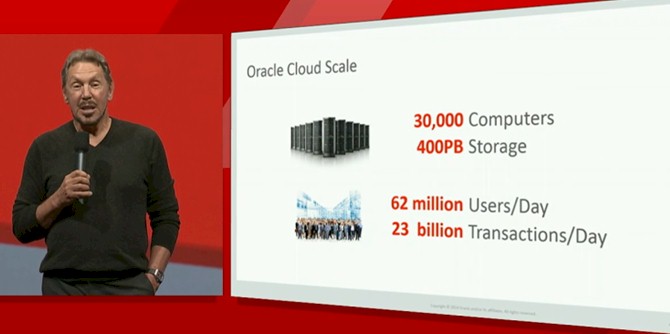Ellison: Oracle’s Cloud Is Bigger Than You Think

The main topic of conversation at the OpenWorld conference held by Oracle in San Francisco this week is the cloud. While Oracle co-founder and now executive chairman and CTO Larry Ellison has famously mocked the idea of the cloud, the company has wholly embraced the idea now after an on-road conversion that ended not in Damascus, but at the company's top and bottom lines. Like other software giants, Oracle has no choice but to embrace the cloud. Having decided that, Oracle figures it is better to use its own hardware and systems software expertise to build and run that cloud rather than drop it out onto AWS or some other public clouds.
This may have not been the plan when Oracle acquired Sun Microsystems nearly five years ago, but this is certainly the game plan now.
To demonstrate Oracle's commitment to the cloud, Ellison rolled out some feeds and speeds during his opening keynote. The software giant has 19 facilities, with a concentration in North America and Europe with a smattering of facilities in Asia and South America.
"I think our cloud is bigger than most people think," said Ellison. "We are going to be a lot bigger than that. It is small compared to Google, but large compared to most applications companies. There are a lot of applications running through our cloud, and it is going to get much, much bigger as infrastructure becomes a utility, like electricity."
The Oracle Cloud has nowhere near the scale of Google Cloud Platform or Microsoft Azure, which have over 1 million servers by various estimates, and it is not really close to the scale of Rackspace Hosting and IBM SoftLayer, which both have over 100,000 machines. (Amazon Web Services is probably somewhere in between these levels, but no one knows for sure.) Oracle's cloud is a bit different in that it is founded on relational databases to do transaction processing and analytics and then has middleware and application layers sometimes wrapped around it. The Oracle Cloud also hosts the SaaS applications that Oracle has either built or bought and that are an increasingly large portion of its software revenues.
Ellison said that Oracle needs to have all levels of cloud – infrastructure, platform, and software services – because without infrastructure services, it would not be possible to run non-Java application on the Oracle Cloud. Some customers will want to be able to do that. Moreover, Ellison said that Oracle has to price its infrastructure services to be competitive with all the key players, and as for whether or not Oracle was worried about making money on infrastructure services, Ellison said he didn't mind being in the commodity business.
"Infrastructure as a service is a commodity, and that is not a bad thing," Ellison explained. "DRAM is a commodity. Oil is a commodity. You can make a living selling a commodity. You have competitors and you have to price aggressively. But we sell out infrastructure at the same price as Amazon, Google, Microsoft, or anyone else that is in that infrastructure as a service business. Our job is to do it with better security and more reliability at the same price."
The one thing that Ellison stressed again and again is that with the latest Oracle Cloud update, customers could move applications, middleware, and now databases to the Oracle cloud – and move them back again if they wanted. But that in many cases, moving it to the cloud was a better option, which is an odd thing perhaps to hear from a chairman and co-founder of a company that has made a living selling software licenses.
"But with just a push of a button, it is compressed, encrypted, and runs in memory – you change not a single line of code and it is faster, it is smaller, it is safer," Ellison said. "Moving your applications and your database to the cloud, it is not just you save money, it is not just that you get capacity on demand. They are so much more reliable. There is so much more automation in the cloud than we used to give you on premise. Yes we provision virtual machines, networks, and storage automatically. But we also do the backups automatically, we do point-in-time recovery for you automatically, and all of the patching and upgrading is done because that is our responsibility."
Ellison added that coming soon, Oracle would be able to automatically provision Real Application Clusters (RAC) clustering for Oracle databases, too. With clusters being a bit of a pain to set up, this might help drive adoption, provided that the pricing is right, of course.












